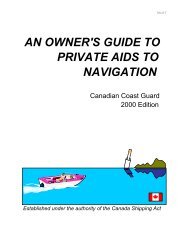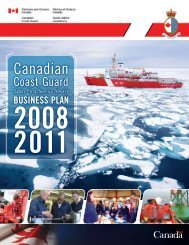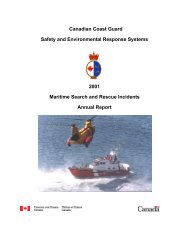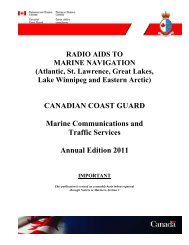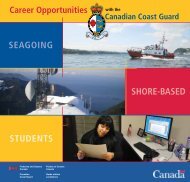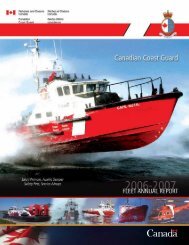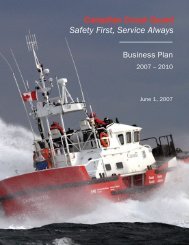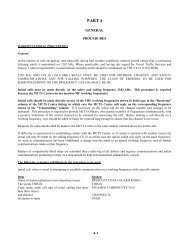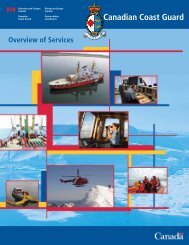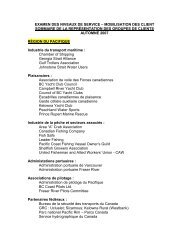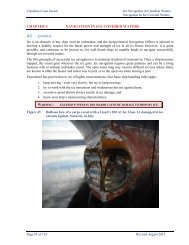Business Plan - Canadian Coast Guard
Business Plan - Canadian Coast Guard
Business Plan - Canadian Coast Guard
You also want an ePaper? Increase the reach of your titles
YUMPU automatically turns print PDFs into web optimized ePapers that Google loves.
FOCUS ON CLIENT SERVICEPriority 2: SupportingGovernment of Canada Priorities14As the owner and operator of Canada’s civilian maritimefleet, the <strong>Canadian</strong> <strong>Coast</strong> <strong>Guard</strong> is often called upon toprovide technical and operational services and advice insupport of Government of Canada priorities.2008-2009 AccomplishmentsThe Northern Strategy• Completed a Mission Profile to advance design and acquisition planning fora new polar icebreaker.• Notified the International Maritime Organization (IMO) of Canada’s intentionto begin satellite broadcast service in two Arctic Navigational Areas onJanuary 1, 2010.Tackling Climate Change and Preserving Canada’s Environment• Developed a training course for senior managers to help ensure effectiveresponse to marine pollution incidents.• Developed a Pollution Response Officer training course for EnvironmentalResponse personnel pursuant to the Canada Shipping Act, 2001 (Part VIII).Maritime Security• On behalf of the International Maritime Organization, led the developmentof the international Long Range Identification and Tracking (LRIT) System.• Fully implemented the land-based Automatic Identification System, including19 Marine Communications and Traffic Services Centres and 110 remote sites.• Delivered the planned interim Marine Security Enforcement Team program forfour vessels on the Great Lakes St. Lawrence Seaway System. A contract is inplace to ensure Law Enforcement Familiarization Training is provided.• Participated in the joint Operation NANOOK 2008, led by the Departmentof National Defence.Support of the Government’sNorthern StrategyCCG has a long and proud history of providing service inthe Arctic and to Northern <strong>Canadian</strong>s. Every year, fromlate June to early November, <strong>Coast</strong> <strong>Guard</strong> deploys onelight, two heavy, and three medium icebreakers to theArctic. In addition to the officers and crew that operatethese icebreakers, close to 70 other CCG employees areassigned to Northern operations on a seasonal basis.This presence of <strong>Coast</strong> <strong>Guard</strong> personnel and assets inCanada’s North helps to protect and secure Canada’sArctic sovereignty, advance the government’s NorthernStrategy, and keep Arctic waterways open, safe, and clean.Budget 2007 provided the <strong>Coast</strong> <strong>Guard</strong> with $2.2million in funding over three years to enhance Canada’scapacity to respond to marine oil spills that occur inthe Arctic. In 2009-10, <strong>Coast</strong> <strong>Guard</strong> will completethe distribution of environmental response equipmentpackages in the North.Also in 2007, the International Maritime Organization(IMO) confirmed Canada in its role as internationalcoordinator and issuing service for navigationalwarnings for two Navigational Areas (NAVAREAs)in the Arctic. NAVAREAS are established geographicalareas within which to coordinate the broadcast ofnavigational warnings to mariners and communities.<strong>Coast</strong> <strong>Guard</strong> plans to begin delivering this service in2010 (see page 34).In 2008, the government took the decision to replace<strong>Coast</strong> <strong>Guard</strong>’s most capable Arctic icebreaker, CCGSLouis S. St-Laurent, built in 1969, and to decommissionit in 2017. Budget 2008 provided $720 million for theprocurement of a new polar-class icebreaker, which isbeing designed with greater icebreaking capabilities thanthe one it is replacing, allowing it to operate for longerperiods in the Arctic. This new vessel will allow the <strong>Coast</strong><strong>Guard</strong> to more efficiently continue its work to strengthenand protect Canada’s sovereignty in the Arctic.Our Arctic activities, many of which are delivered in partnershipwith others, include:• Escorting commercial ships through ice to ensure accessto Northern communities;• Supporting scientific endeavours such as hydrographic chartingand marine science;• Maintaining some aids to navigation in <strong>Canadian</strong> Arcticwaterways;• Acting as the primary response lead for pollution incidentsnorth of 60;• Providing marine search and rescue services;• Operating two seasonal Arctic Marine Communicationsand Traffic Services Centres: Inuvik in the west and Iqaluitin the east;• Broadcasting weather information and navigational warnings;• Delivering food, cargo, and fuel to remote sites wherecommercial ships do not go;• Conducting joint exercises with the Department of NationalDefence (Operation NANOOK 2008, for example); and• Developing an improved awareness of the Arctic maritimedomain through vessel identification and trackingsecurity initiatives.<strong>Canadian</strong> <strong>Coast</strong> <strong>Guard</strong> — www.ccg-gcc.gc.ca



